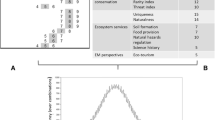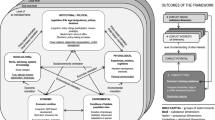Abstract
Explicit, quantitative procedures for identifying biodiversity priority areas are replacing the often ad hoc procedures used in the past to design networks of reserves to conserve biodiversity. This change facilitates more informed choices by policy makers, and thereby makes possible greater satisfaction of conservation goals with increased efficiency. A key feature of these procedures is the use of the principle of complementarity, which ensures that areas chosen for inclusion in a reserve network complement those already selected. This paper sketches the historical development of the principle of complementarity and its applications in practical policy decisions. In the first section a brief account is given of the circumstances out of which concerns for more explicit systematic methods for the assessment of the conservation value of different areas arose. The second section details the emergence of the principle of complementarity in four independent contexts. The third section consists of case studies of the use of the principle of complementarity to make practical policy decisions in Australasia, Africa, and America. In the last section, an assessment is made of the extent to which the principle of complementarity transformed the practice of conservation biology by introducing new standards of rigor and explicitness.
Similar content being viewed by others
References
Ackery P R and Vane-Wright R I 1984Milkweed butterflies (Cornell: Cornell University Press)
Aggarwal A, Garson J, Margules C R, Nicholls A O and Sarkar S 2000ResNet manual ver 1.1 (Austin: Biodiversity and Biocultural Conservation Laboratory, University of Texas at Austin)
Andelman S, Ball I, Davis F and Stoms D 1999SITES V 1.0 an analytic toolbox for designing ecoregional conservation portfolios (Santa Barbara: The Nature Conservancy)
Austin M A and Miller D J 1978 Conservation; inLand use on the south coast of New South Wales: a study in acquiring and using information to analyse regional land use options (eds) M P Austin and K D Cocks (Melbourne: CSIRO) pp 169–195
Australian and New Zealand Environment and Conservation Council (ANZECC), Ministerial Council on Forestry, Fisheries and Aquaculture (MCFFA) of the Commonwealth of Australia, and National Forest Policy Statement Implementation Sub-committee 1997Comprehensive, adequate and representative reserve system for forests in Australia (Canberra: Australian Government Publishing Service)
Cabeza M and Moilanen A 2001 Design of reserve networks and the persistence of biodiversity;Trends Ecol. Evol. 16 242–248
Church R L, Stoms D M and Davis F W 1996 Reserve selection as a maximal covering location problem;Biol. Conserv. 76 105–112
Clark F S and Slusher R B 2000 Using spatial analysis to drive reserve design: a case study of a national wildlife refuge in Indiana and Illinois (USA);Landscape Ecol. 15 75–84
Cocks B and Baird I A 1989 Using mathematical programming to address the multiple reserve selection problem: an example from the Eyre Peninsula South Africa;Biol. Conserv. 49 113–130
Commonwealth of Australia 1992National forest policy statement: A new focus for Australia’s forests (Canberra: Australian Government Publishing Service)
Commonwealth of Australia 1995National forest conservation reserves: commonwealth proposed criteria (Canberra: Australian Government Publishing Service)
Commonwealth of Australia 1999International forest conservation: protected areas and beyond (Canberra: Australian Governmental Publishing Service)
Cowling R 1999 Planning for persistence — systematic reserve design in southern Africa’s Succulent Karoo Desert;Parks 9 17–30
Cowling R M, Pressey R L, Lombard A T, Desmet P G and Ellis A G 1999 From representation to persistence: requirements for a sustainable system of conservation areas in the species-rich Mediterranean-climate desert of southern Africa;Diver. Distrib. 5 51–71
Csuti B, Polansky S, Williams P H, Pressey R L, Camm J D, Kershaw M, Kiester A R, Downs B, Hamilton R, Huso M and SahrK 1997 A comparison of reserve selection algorithms using data on terrestrial vertebrates in Oregan;Biol. Conserv. 80 83–90
Everett R D 1978Conservation evaluation and recreational importance of wildlife within a forestry area, D. Phil thesis, University of York, UK
Faith D P, Nix H A, Margules C R, Hutchinson M F, Walker P A, West J, Stein J L, Kesteven J L, Allison A and Natera G 2001a The BioRap biodiversity assessment and planning study for Papua New Guinea;Pac. Conserv. Biol. 6 279–288
Faith D P, Margules C R, Walker P A, Stein J and Natera G 2001b Practical application of biodiversity surrogates and percentage targets for conservation in Papua New Guinea;Pac. Conserv. Biol. 6 289–303
Faith D P, Margules C R and Walker P A 2001c A biodiversity conservation plan for Papua New Guinea based on biodiversity trade-offs analysis;Pac. Conserv. Biol. 6 304–324
Faith D P, Walker P A and Margules C R 2001d Some future prospects for systematic biodiversity planning in Papua New Guinea — and for biodiversity planning in general;Pac. Conserv. Biol. 6 325–343
Ferrier S, Pressey R L and Barrett T 2000 A new predicator of the irreplaceability of areas for achieving a conservation goal, its application to real-world planning, and a research agenda for further refinement;Biol. Conserv. 93 303–325
Finkel E 1998a Software helps Australia manage forest debate;Science 281 1789–1791
Finkel E 1998b Forest Pact Bypasses Computer Model;Science 282 1968–1969
Garson J, Aggarwal A and Sarkar S 2002 Birds as surrogates for biodiversity: an analysis of a data set from southern Québec;J. Biosci. (Suppl. 2)27 347–360
Gehlbach F R 1975 Investigation, evaluation, and priority ranking of natural areas;Biol. Conserv. 8 79–88
Goldsmith F B 1975 The evaluation of ecological resources in the countryside for conservation purposes;Biol. Conserv. 8 89–96
Groves C, Valutis L, Vosick D, Neely B, Wheaton K, Touval J and Runnels B 2000Designing a geography of hope: a practitioner’s handbook for ecoregional conservation planning 2nd edition (Arlington: Nature Conservancy)
Howard P C, Viskanic P, Davenport, Tim R B, Kigenyi F W, Baltzer M, Dickinson C J, Lwanga J, Matthews R A and Balmford A 1998 Complementarity and the Use of Indicator Groups for Reserve Selection in Uganda;Nature (London)394 472–475
Kirkpatrick J B 1983 An iterative method for establishing priorities for the selection of nature reserves: an example from Tasmania;Biol. Conserv. 25 127–134
Lombard A T, Cowling R M, Pressey R L and Mustart P J 1996 Reserve selection in a species-rich and fragmented landscape on the Agulhas plain, South Africa;Conserv. Biol. 11 1101–1116
Lombard A T, Hilton-Taylor C, Rebelo A G, Pressey R L and Cowling R M 1999 Reserve Selection in the Succulent Karoo, South Africa: Coping with High Compositional Turnover;Plant Ecol. 142 35–55
Margules C and Usher M B 1981 Criteria used in assessing wildlife conservation potential: a review;Biol. Conserv. 2179–109
Margules C R, Nicholls A O, Pressey R L 1988 Selecting networks of reserves to maximise biological diversity;Biol. Conserv. 43 63–76
Margules C R, Redhead T D, Faith D P and Hutchinson M F 1995Guidelines for using the biorap methodology and tools (Australia: CSIRO)
Ministry of Town and Country Planning 1947aConservation of Nature in England and Wales (London: HMSO)
Ministry of Town and Country Planning 1947bNational Parks and the Conservation of Nature in Scotland (London: HMSO)
Nicholls A O and Margules C R 1993 An Upgraded Reserve Selection Algorithm;Biol. Conserv. 64 165–169
Nix H A, Faith D P, Hutchinson M F, Margules C R, West J, Allison A, Kesteven J L, Natera G, Slater W, Stein J L and Walker P 2000The bioRap toolbox a national study of biodiversity assessment and planning for Papua New Guinea (Canberra: Centre for Resource and Environmental Studies, Australian National University)
Poore M E D 1971 Introductory remarks by the chairman;Adv. Sci. 27 291
Prendergast J R, Quinn R M and Lawton J H 1999 The gaps between theory and practice in selecting nature reserves;Conserv. Biol. 13 484–492
Pressey R L 1994Ad hoc reservations: forward or backward steps in developing representative reserve systems?;Conserv. Biol. 8 662–668
Pressey R L 1998 Algorithms, politics and timber: an example of the role of science in a public, political negotiation process over new conservation areas in production forests; inEcology for everyone: communicating ecology to scientists, the public and the politicians (eds) R T Wills and R I Hobbs (Surrey: Beatty) pp 73–87
Pressey R L 1999 Applications of irreplaceability analysis to planning and management problems;Parks 9 42–51
Pressey R L and Cowling R M 2001 Reserve selection algorithms and the real world;Conserv. Biol. 15 275–277
Pressey R L and Nicholls A O 1989 Application of a numerical algorithm to the selection of reserves in semi-arid New South Wales;Biol. Conserv. 50 263–278
Pressey R L, Possingham P H and Day R J 1997 Effectiveness of Alternative Heuristic Algorithms for Identifying Indicative Minimum Requirements for Conservation Reserves;Biol. Conserv. 80 207–219
Ratcliffe D A 1971 Criteria for the selection of nature reserves;Adv. Sci. 27 294–296
Ratcliffe D A 1977The selection of biological sites of national importance to nature conservation in Britain (Cambridge: Cambridge University Press)
Rebelo R L 1989 Conservation; inVegetation of Southern Africa (eds) R M Cowling, D M Richardson and S M Pierce (Cambridge: Cambridge University Press) pp 571–590
Rebelo A G and Siegfried W R 1990 Protection of Fynbos vegetation: ideal and real-world options;Biol. Conserv. 54 15–31
Redford K, Andrews M, Braun D, Buttrick S, Chaplin S, Coon M, Cox R, Ellis L, Grossman D, Groves C, Livermore D, Pearsall S, Shopland J, Tabas P, Wall K, Williamson D and Rousmaniere N 1997Designing a geography of hope: guidelines for ecoregion conservation in the Nature Conservancy (Arlington: Nature Conservancy)
Richardson K S and Funk V A 1999 An Approach to Designing a Systematic Protected Area System in Guyana;Parks 9 7–16
Sarkar S 2002 Defining "biodiversity" assessing biodiversity;Monist 85 131–155
Sarkar S, Aggarwal A, Garson J, Margules C R and Zeidler J 2002 Place prioritization for biodiversity content;J. Biosci. (Suppl. 2)27 339–346
Sarkar S, Parker N C, Garson J, Aggarwal A and Haskell S 2000 Place prioritization for Texas using GAP data: the use of biodiversity and environmental surrogates within socio-economic constraints;GAP Anal. Bull. 9 76–82
Sarakinos H, Nicholls A O, Tubert A, Aggarwal A, Margules C R, Sarkar S 2001 Area prioritization for biodiversity conservation in Québec on the basis of species distributions: a preliminary analysis;Biodiver. Conserv. 10 1419–1472
Tans W 1974 Priority ranking of biotic natural areas;Michigan Bot. 13 31–39
Tubbs C R and Blackwood J W 1971 Ecological evaluation of land for planning purposes;Biol. Conserv. 3 169–172
Underhill L G 1994 Optimal and suboptimal reserve selection algorithms;Biol. Conserv. 70 85–87
van Der Ploeg SWF and Vlijm L 1978 Ecological evaluation, nature conservation and land use planning with particular reference to methods used in the Netherlands;Biol. Conserv. 14 197–221
Vane-WrightR I, Humphries C J and Williams P H 1991 What to protect — systematics and the agony of choice;Biol. Conserv. 55 235–254
Walker P A and Faith D P 1998TARGET Software priority area setting (Canberra: CSIRO Division of Wildlife and Ecology)
Williams P H, Burgess N D and Rahbek C 2000 Flagship species, ecological complementarity, and conserving the diversity of mammals and birds in sub-Saharan Africa;Anim. Conserv. 3 249–260
Williams P H, Gibbons D, Margules C, Rebelo A, Humphries C and Pressey R 1996 A comparison of richness hotspots, rarity hotspots and complementary areas for conserving diversity using British birds;Conserv. Biol. 10 155–174
Williams P H, Humphries C, Araujo M, Lampinen R, Hagemeijer W, Gasc J P and Mitchell-Jones T 2000 Endemiism and important areas for conserving European diversity: a preliminary exploration of atlas data for plants and terrestrial vertebrates;Belgian J. Entomol. 2 21–46
Wright D F 1977 A site evaluation scheme for use in the assessment of potential nature reserves;Biol. Conserv. 11 293–305
WWF-UQCN (World Wide Fund for Nature, Bureau de Québec-union québecoise pour la conservation de la nature) 1998Les milieux naturels de Québec méridional: Premiére approximation (Montréal, Québec: WWF-UQCN)
Author information
Authors and Affiliations
Corresponding author
Rights and permissions
About this article
Cite this article
Justus, J., Sarkar, S. The principle of complementarity in the design of reserve networks to conserve biodiversity: A preliminary history. J Biosci 27, 421–435 (2002). https://doi.org/10.1007/BF02704970
Issue Date:
DOI: https://doi.org/10.1007/BF02704970




